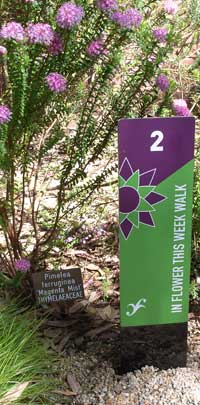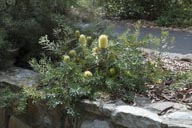In Flower This Week
A weekly news sheet prepared by a Gardens' volunteer.
Numbers before each plant refer to temporary IFTW labels in the gardens.
Numbers in square brackets [ ] refer to garden bed Sections. Plants in flower are in bold type.
View past issues of 'In Flower This Week'.
5 March 2014
Banksia marginata 'Cape Patterson Dwarf' click for larger image |
Today we start at the café and walk around the Main Path.
- Just outside the café on the left is a medium-sized bush of Correa alba [Section 131] with grey-green leaves and white star flowers. This correa is a popular and reliable plant in the garden. It is native to southeastern coastal regions of Australia, ranging from northern NSW to eastern South Australia and into Tasmania.
- Nearby is a large bush of Syzygium australe [Section 131] with fluffy white flowers and red drooping fruit.
- Further along the path on the right is Correa ‘Summer Belle’ [Section 240] with pink bells with greenish tips. ‘Summer Belle’ was developed from a seedling found growing in the garden of Neil Marriott of Stawell, Victoria.
- Continue along the Main Path as it wends its way uphill through grass trees and waratahs. On the left is Banksia ericifolia var. ericifolia [Section 30] with green developing flower-heads which mature into long gold candles on bright green heath-like foliage. Heath-leaved Banksia is one of the bestknown members of the genus, having been in widespread cultivation for many years.
- Just around the next corner on your right is Grevillea phanerophlebia [Section 27], or Prominent Vein Grevillea, with white starburst terminal flowers on an airy bush. This Western Australian plant is threatened in the wild.
- A little further on and to the left is Callistemon ‘Reeve’s Pink’ [Section 30] with bright pink brush-like flowers in profusion. This callistemon was developed from a chance seedling of uncertain parentage which originated at the nursery of Mr Reeve Snr. at Cheltenham, Victoria.
- Just before crossing the road look to the right for Grevillea ‘Coconut Ice’ [Section 25], with large pink/orange spider flowers with long red styles. It is a hybrid plant grown from seed collected from G. bipinnatifida. The male parent was a white-flowered form of G. banksii. The seedling was raised by Mr. M. Hodge of Queensland.
- On the far side of the road is Banksia marginata ‘Cape Patterson Dwarf’ [Section 26] on the right is an unusual small version of our common local Banksia marginata. It has short lime-green candles on dark green leaves with silver undersides.
- Just a little further on and to your right is Persoonia acerosa [Section 26], or Needle Geebung. It has yellow spiky flowers at the ends of bright green foliage.
- On the right after crossing the next road is Correa ‘Marian’s Marvel’ [Section 112] with flared pale pink bells with greenish tips. This beautiful cross between C. reflexa and C. backhouseana arose in the garden of Mrs Marion Beek of Naracoorte, South Australia.
- On the left is Acacia linifolia [Section 191e], a small tree with sweetly-scented pale yellow balls on fine needle-like foliage. This wattle will tolerate shade and is very hardy.
- After crossing the Eucalypt Lawn, on the left is Podolobium aciculiferum [Section 18] with long-lasting yellow pea flowers on spiky triangular foliage.
- Further on the left is Acacia subulata [Section 18], or Awl-leaf Wattle, with airy fine foliage and scented yellow balls of flower for long periods of time.
- Look up on your left to see Acacia parvipinnula [Section 18], or Silver-stemmed Wattle, which is a tree of ferny foliage and yellow balls of flower. Continue on the Main Path down to the Rockery.
- After passing the waterfall, leave the Main Path and turn left onto the road down the hill towards the café. On your right is Epacris longiflora [Section 110], or Fuchsia Heath, showing red tubular flowers with white tips on a spiky bush of close foliage.
Rosalind Walcott
![Director of National Parks [logo]](../../../../images/dnp_90px.gif)







